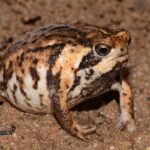- Introduction: A Peek into the Mysteries of Ischnocnema crassa
- Taxonomy and Classification: Understanding Ischnocnema crassa's Family Tree
- Natural Habitat: Embracing the Shadows of Brazil's Atlantic Forest
- Physical Characteristics: Subtle Beauty in Miniature Form
- Behavior and Life Cycle: Remarkable Adaptations in Amphibious Nature
- Ecological Role: A Crucial Piece within the Forest Puzzle
- Threats and Conservation Status: Preserving a Hidden Gem
- Cultural and Scientific Significance: Small Frog, Big Meaning
- Conclusion: Protecting Ischnocnema crassa, Protecting our Planet
Introduction: A Peek into the Mysteries of Ischnocnema crassa#
Amidst the lush, forested slopes of Brazil’s Atlantic Forest lies a small, inconspicuous creature whose presence often goes unnoticed—the enigmatic Ischnocnema crassa. Despite the vibrant cacophony of wildlife that echoes through these tropical ecosystems, this cryptic frog quietly thrives, hidden within leaf litter and shaded undergrowth. Its subtle lifestyle may escape casual observers, but its ecological role is undeniably vital, acting as both predator and prey in a delicate natural balance.
Belonging to the broad amphibian family Brachycephalidae, the Ischnocnema crassa frog exhibits behaviors and adaptations so unique they astonish scientists and wild enthusiasts alike. Did you know that this curious frog bypasses the tadpole stage altogether? Fascinating adaptations like direct egg development provide just a hint of the mysteries surrounding this charismatic amphibian species.
Taxonomy and Classification: Understanding Ischnocnema crassa’s Family Tree#
Scientifically recognized as Ischnocnema crassa, this frog belongs to the Brachycephalidae family, genus Ischnocnema, a group known for their terrestrial lifestyles and unusual reproductive strategies. Described first scientifically by Lutz in 1958, the species is part of a genus with over 30 identified members—widely diverse yet consistently fascinating in their adaptations to a terrestrial way of life.
Among its close relatives are several small-bodied, forest-floor frogs sharing similar ecological niches and reproductive patterns. However, despite similarities, Ischnocnema crassa distinguishes itself through its distinct morphological features and habitat preferences.
Natural Habitat: Embracing the Shadows of Brazil’s Atlantic Forest#
Ischnocnema crassa primarily inhabits Brazil’s coastal Atlantic Forest, a biodiversity hotspot recognized for its astonishing array of plant and animal life. Here, beneath towering tree canopies draped in vines, a complex ecosystem thrives in perpetual dimness and moisture. Humidity clings thickly to the air, while layers of fallen leaves continuously form realms teeming with insects, spiders, fungi, and, importantly, cryptic amphibians like our elusive frog.
This terrestrial frog greatly prefers lowland to mid-elevation humid forests—habitats that offer a perfect blend of moisture, shelter, and abundant prey. Its choice to dwell within the leaf litter provides optimal camouflage from predators such as birds and larger frogs, while simultaneously keeping it positioned amongst bountiful food resources.
These forest ecosystems also offer stable climate conditions critical for its sensitive skin—ample moisture to protect against dehydration and ideal conditions for reproduction. Loss of such habitats, due largely to deforestation and urbanization, directly threatens this sensitive amphibian’s existence.
Physical Characteristics: Subtle Beauty in Miniature Form#
Measuring typically around 15 to 30 millimeters in length, the Ischnocnema crassa frog may seem diminutive and unassuming at first glance. Yet, closer observation reveals subtle beauty and incredible adaptations finely attuned to its secretive lifestyle.
Its body is robust and slightly stocky, reflective of its Latin-derived species name “crassa,” meaning “thick” or “stout.” The coloration typically ranges from earthy shades of brown and tan, seamlessly melding with the forest’s leaf litter. Patterns of darker stripes, speckles, and subtle blotches adorn its back, enhancing its camouflage strategy as it moves stealthily among decaying foliage.
Meanwhile, its stumpy legs are specifically adapted for short-distance hops, perfect for navigating through dense litter rather than bounding leaps. Its skin texture is slightly granular, allowing subtle patterns and texture nuances to enhance concealment on the forest floor. Larger eyes relative to body size further aid nocturnal hunting habits, enhancing perception in low-light conditions as it searches out prey amongst the shadows and moisture.
Behavior and Life Cycle: Remarkable Adaptations in Amphibious Nature#
Diet and Hunting Strategies#
Barely visible amid leaf shadows, Ischnocnema crassa emerges at twilight—its prime hunting hours—to feed upon small insects, spiders, mites, and invertebrates. Rather than actively chasing prey, it displays a sit-and-wait feeding method. Patiently concealed beneath fallen leaves or soils, it relies on sharp vision and acute sensitivity to vibrations being transmitted through the substrate, quickly lunging at prey that inadvertently approaches.
Unique Reproductive Habits#
One especially unique trait among this fascinating genus is their omission of an aquatic tadpole stage, a marked departure from traditional amphibian reproduction. Females deposit eggs amid moist leaf litter or within small crevices in logs and rocks. Here, eggs develop directly into miniature froglets, bypassing the tadpole phase entirely—remarkable evidence of evolutionary ingenuity.
This direct development serves as an evolutionary advantage, freeing them from dependence on standing water bodies and limiting exposure to aquatic predators like fish, larvae, or aquatic insects. Yet, this strategy places the survival of developing embryos squarely dependent on maintaining ideal moisture conditions within their terrestrial habitats—another indicator of their extreme sensitivity to environmental changes.
Ecological Role: A Crucial Piece within the Forest Puzzle#
Unassuming as it may be, Ischnocnema crassa plays a disproportionately significant ecological role. As voracious insectivores, they exert meaningful control over forest-floor insect populations. By regulating prey abundance, these frogs contribute indirectly to maintaining a balanced ecosystem, supporting harmonious interactions between varied forest flora and fauna.
Simultaneously, their status as vulnerable prey species makes them essential actors in the food web, providing valuable nutrition to larger animals such as birds, reptiles, mammals, and even other amphibian species. Furthermore, amphibians are widely regarded as indicators of ecosystem health, and the presence—or absence—of Ischnocnema crassa can serve as an important signal for the ecological condition of the entire Atlantic Forest biome.
Threats and Conservation Status: Preserving a Hidden Gem#
Sadly, like many fellow amphibians globally, the Ischnocnema crassa frog faces increasing threats, predominantly driven by habitat loss, degradation, and fragmentation. Rampant deforestation for agriculture, urban development, and industrial expansion continuously erode their precious forested homes, reducing much-needed habitat and severely impacting their reproductive success rates and feeding opportunities.
Climate change also poses a growing threat, altering weather patterns and moisture availability within already fragile ecosystems. Amphibians, with permeable skin highly sensitive to environmental shifts, disproportionately bear the brunt of ecological changes. The International Union for Conservation of Nature (IUCN) currently has limited detailed assessments for this species due to data deficiency, yet conservationists agree these frogs warrant closer attention and urgent habitat protection.
Initiatives aimed at preserving or restoring the Atlantic Forest—such as establishment of wildlife corridors, protected areas, sustainable agroforestry practices, and public awareness campaigns—are crucial to ensuring the continued existence of this unique amphibian species.
Cultural and Scientific Significance: Small Frog, Big Meaning#
Though subtle and hidden from everyday human life, frogs like Ischnocnema crassa offer important scientific insights as valuable bioindicators. Monitoring their populations and distribution provides the scientific community and policymakers alike with invaluable data regarding the Atlantic Forest’s ecological health.
Beyond pure biology, species like Ischnocnema crassa often inspire traditional folklore and cultural storytelling, representing nature’s subtle, delicate, and elusive beauty to local indigenous communities and biodiversity enthusiasts. Their continued survival offers an ongoing impetus for responsible conservation behaviors on both scientific and cultural fronts.
Conclusion: Protecting Ischnocnema crassa, Protecting our Planet#
The captivating yet elusive frog Ischnocnema crassa offers much more than mere biological curiosity—it symbolizes the delicate intricacies inherent in nature’s designs and proves how easily human activities can disrupt ecological balances. Protecting this secretive species entails safeguarding one of Earth’s most remarkable and irreplaceable biodiversity hotspots: the Atlantic Forest.
We encourage continued exploration, citizen science participation, and strong conservation policies to ensure Ischnocnema crassa, along with countless other species sharing its habitat, continue quietly thriving amid the tangled green wonderland of Brazil’s remaining wilderness. After all, the health of such humble creatures ultimately reflects and ensures the health of our shared planet.







